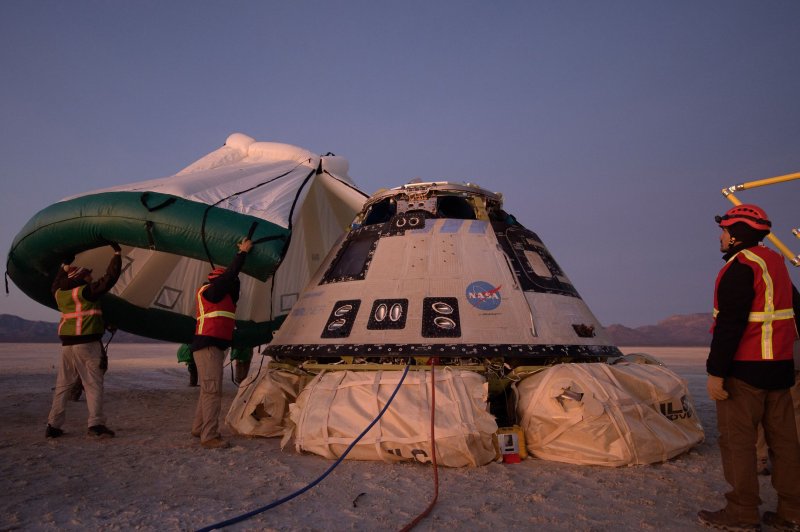1 of 2 | Boeing, NASA and U.S. Army personnel work around the Boeing CST-100 Starliner spacecraft shortly after it landed in White Sands, N.M., on Sunday. NASA Photo by Bill Ingalls/UPI |
License Photo
Dec. 22 (UPI) -- Boeing's Starliner spacecraft landed at the White Sands Space Harbor in New Mexico on Sunday morning, marking the first time a United States "crew-capable" space capsule, aside from the shuttle, made a touchdown on land.
The Starliner, which did not have a crew on board, hopes to one day soon ferry U.S. astronauts to the International Space Station and bring them back.
The capsule returned from space earlier than expected when its trip to the space station was aborted. That docking was scrubbed when an error with the mission timer onboard the spacecraft malfunctioned, causing the Starliner to burn too much fuel during an early orbital maneuver.
The landing, though, went off without a hitch. The capsule re-entered the atmosphere, deployed three parachutes and ditched its heat shield before reaching land, all as intended.
"When you look at the landing, it was an absolute bullseye,"NASA Administrator Jim Bridenstine said in a news conference later Sunday morning. "It was better than I think anyone had anticipated. That's good for the agency, that's good for Boeing and good for the United States of America."
"When we think about the end-to-end test ... a lot of things went right. I said that on Friday, and a lot more things went right today. We're very excited about the future," he added.
Jim Chilton, Boeing's vice president of space and launch, echoed Bridenstine's comments, saying the Starliner's performance was exceptional despite never reaching the space station.
"Return is something you really can't test," Chilton said. "You have to put your heat shield on and go through the heat regime. Today couldn't have gone any better. From an overall perspective, we're as pleased as we can be with the design."
The desert landing was noteworthy because past U.S. spacecraft in the Mercury, Gemini and the Apollo programs all landed in the ocean. Private space companies like SpaceX, though, have been perfecting land touchdowns as the industry moves toward reusable space vehicles.
Starliner orbited Earth 33 times about 155 miles above the planet. Despite the mission timer failure, officials said it accomplished other tests that will benefit it on future flights. A test dummy dubbed "Rosie the Rocketeer" wore sensors to measure what astronauts would actually feel during launch and landing.
NASA has not decided whether to require a second unmanned Starliner test flight before sending astronauts to the space station. The space agency said avionics, life support, thermal management, power, attitude control and instrumentation all performed well.















